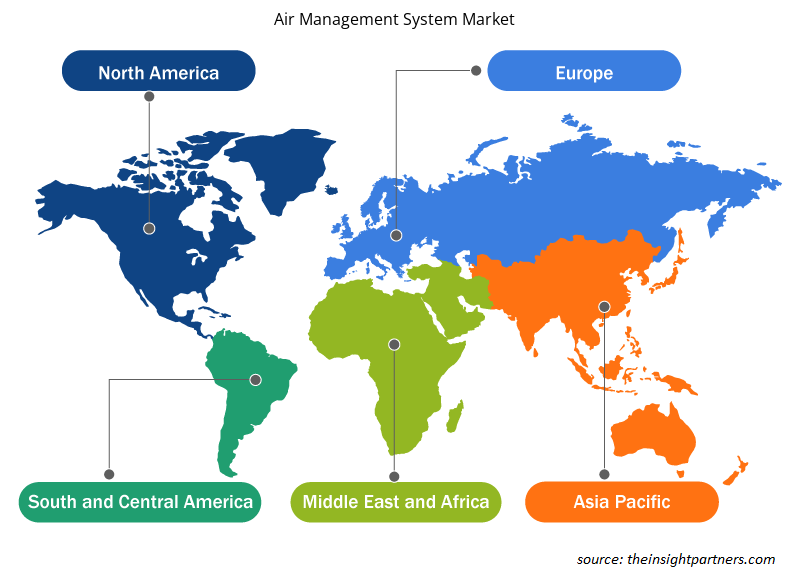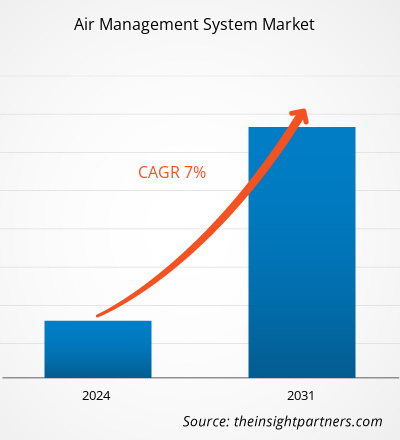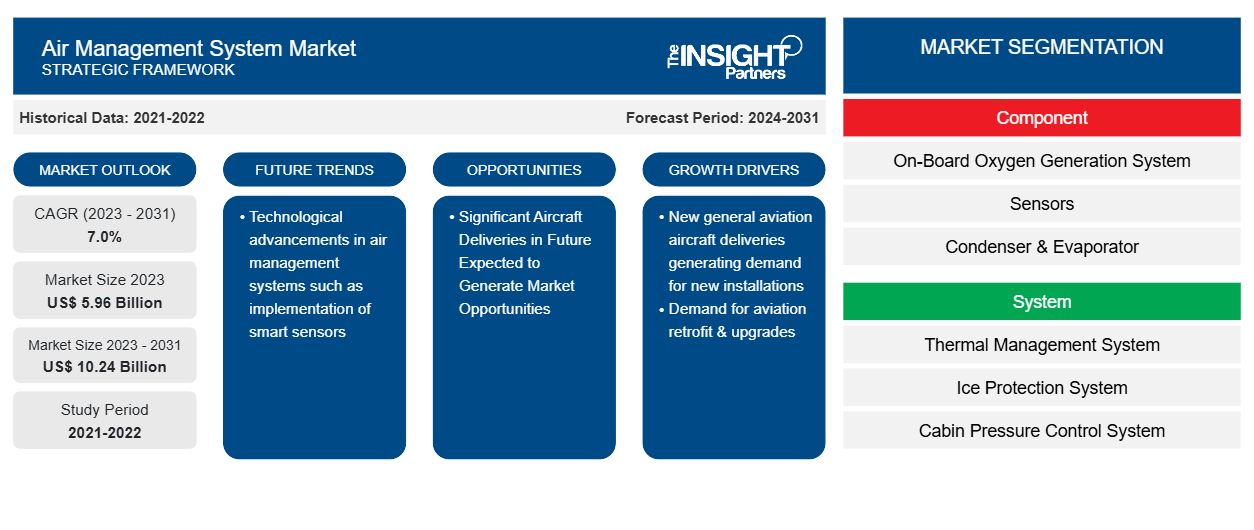من المتوقع أن يصل حجم سوق أنظمة إدارة الهواء إلى 10.24 مليار دولار أمريكي بحلول عام 2031 من 5.96 مليار دولار أمريكي في عام 2023. ومن المتوقع أن يسجل السوق معدل نمو سنوي مركب بنسبة 7.0٪ خلال الفترة 2023-2031. ومن المرجح أن تظل التطورات التكنولوجية في أنظمة إدارة الهواء مثل تنفيذ أجهزة الاستشعار الذكية اتجاهًا رئيسيًا في السوق.
تحليل سوق نظام إدارة الهواء
إن النظام البيئي لسوق أنظمة إدارة الهواء متنوع ومتطور. وأصحاب المصلحة فيه هم الموردون والمكونات ومصنعو الطائرات والمستخدمون النهائيون. يشغل اللاعبون الرائدون أماكن في عقد مختلفة من النظام البيئي للسوق. يوفر مزودو المواد الخام المواد لمصنعي المكونات، ويستخدمونها لتصنيع وتصميم المنتجات النهائية. ثم يتم توريد المنتج النهائي لمصنعي الطائرات من خلال وسائل مختلفة، مثل المبيعات المباشرة من خلال موزعي الشركة أو المبيعات من جهات خارجية من خلال موزعين تابعين لجهات خارجية. ثم يقوم مصنعو الطائرات أو الشركات المصنعة للمعدات الأصلية بدمج مكونات الطائرات في نماذج الطائرات الخاصة بهم.
نظرة عامة على سوق أنظمة إدارة الهواء
يتألف سوق نظام إدارة الهواء من العديد من اللاعبين الراسخين حيث يستحوذ أكبر خمسة بائعين على حوالي 25٪ ويختبرون عمليات شراء منتظمة لمنتجاتهم من المستخدمين النهائيين. يتنافس لاعبو سوق نظام إدارة الهواء فيما بينهم على معايير مختلفة، بما في ذلك التكنولوجيا ووقت التسليم والتسعير، من بين أمور أخرى. تعمل هذه المعايير على تعزيز القدرة التنافسية بين اللاعبين في السوق ومن المتوقع أن تحافظ على مستوى عالٍ من التنافس التنافسي بين اللاعبين في سوق نظام إدارة الهواء.
قم بتخصيص هذا التقرير ليناسب متطلباتك
ستحصل على تخصيص لأي تقرير - مجانًا - بما في ذلك أجزاء من هذا التقرير، أو تحليل على مستوى الدولة، وحزمة بيانات Excel، بالإضافة إلى الاستفادة من العروض والخصومات الرائعة للشركات الناشئة والجامعات
-
احصل على أهم اتجاهات السوق الرئيسية لهذا التقرير.ستتضمن هذه العينة المجانية تحليلاً للبيانات، بدءًا من اتجاهات السوق وحتى التقديرات والتوقعات.
محركات وفرص سوق أنظمة إدارة الهواء
الطلب على تحديث وتطوير الطيران
إن وجود عدد كبير من أساطيل الطيران التجاري القديمة في جميع أنحاء العالم يولد الطلب على إعادة تأهيل وترقية الأسطول الحالي. كما أن إطلاق حظائر صيانة وإصلاح الطائرات الجديدة ومناطق الصيانة والإصلاح يتناسب بشكل مباشر مع الطلب على أنظمة إدارة الهواء المختلفة، وهو أحد المحفزات القوية لسوق أنظمة إدارة الهواء. بالإضافة إلى ذلك، فإن الاستثمارات المستمرة من قبل شركات الطيران لترقيات الطائرات بسبب توسع أسطولها الحالي من الطائرات تعزز الطلب على أنظمة إدارة الهواء على مستوى العالم. على سبيل المثال، وقعت إحدى الشركات الرائدة في مجال الطيران الهندي، InterGlobe Aviation Ltd. (Indigo Airlines)، اتفاقية مدتها 20 عامًا مع Bangalore International Airport Limited (BIAL) في عام 2019 لبناء ثاني منشأة صيانة وإصلاح وعمرة في الهند. ووفقًا لبيان الشركة، يمكن للحظيرة الجديدة خدمة طائرتين ضيقتي البدن ومحرك MRO.
من المتوقع أن تؤدي عمليات تسليم الطائرات المهمة في المستقبل إلى خلق فرص سوقية
حافظ قطاع الطيران التجاري على حجم أسطول قوي على مر السنين، حيث تعد إيرباص وبوينج من أبرز مصنعي الطائرات من حيث إحصائيات التسليم. شهدت صناعة الطيران التجاري نموًا هائلاً في السنوات القليلة الماضية مع ظهور شركات طيران منخفضة التكلفة جديدة واستراتيجيات توسيع الأسطول التي تبنتها شركات الطيران ذات الخدمة الكاملة. ومن المتوقع أن يشهد الطيران التجاري ارتفاعًا في السنوات القادمة بسبب العدد المتزايد من ركاب السفر الجوي وشراء الطائرات. علاوة على ذلك، فإن عمليات التسليم المستقبلية المتوقعة للطائرات التجارية والعسكرية هي أحد العوامل الرئيسية التي من المرجح أن تولد فرصًا جديدة لبائعي السوق في السنوات القادمة. على سبيل المثال، وفقًا لتوقعات بوينج وإيرباص، من المرجح أن يتم تسليم أكثر من 40800 طائرة تجارية في جميع أنحاء العالم خلال الفترة 2023-2042.
تقرير تحليل تجزئة سوق نظام إدارة الهواء
إن القطاعات الرئيسية التي ساهمت في اشتقاق تحليل سوق نظام إدارة الهواء هي المكون والنظام والمنصة.
- بناءً على المكون، يتم تقسيم سوق نظام إدارة الهواء إلى نظام توليد الأكسجين على متن الطائرة، وأجهزة الاستشعار، والمكثف والمبخر، وآلات دورة الهواء، ووحدات التحكم والمراقبة الإلكترونية، وغيرها. احتل قطاع آلات دورة الهواء حصة سوقية أكبر في عام 2023.
- بناءً على النظام، يتم تقسيم سوق نظام إدارة الهواء إلى نظام إدارة حرارية، ونظام حماية الجليد، ونظام التحكم في ضغط المقصورة، ونظام إخماد خزان الوقود، ونظام الأكسجين، ونظام نزف الهواء للمحرك. احتل قطاع نظام الإدارة الحرارية حصة سوقية أكبر في عام 2023.
- بناءً على المنصة، يتم تقسيم سوق أنظمة إدارة الهواء إلى جناح ثابت وجناح دوار. احتلت شريحة الجناح الثابت حصة سوقية أكبر في عام 2023.
تحليل حصة سوق أنظمة إدارة الهواء حسب المنطقة الجغرافية
ينقسم النطاق الجغرافي لتقرير سوق نظام إدارة الهواء بشكل أساسي إلى خمس مناطق: أمريكا الشمالية وأوروبا وآسيا والمحيط الهادئ والشرق الأوسط وأفريقيا وأمريكا الجنوبية.
سيطرت منطقة آسيا والمحيط الهادئ على السوق في عام 2023 تليها مناطق أمريكا الشمالية وأوروبا. علاوة على ذلك، من المرجح أن تشهد منطقة آسيا والمحيط الهادئ أيضًا أعلى معدل نمو سنوي مركب في السنوات القادمة. استحوذت الصين على حصة كبيرة في سوق نظام إدارة الهواء في منطقة آسيا والمحيط الهادئ بينما من المرجح أن تكون الهند واحدة من أكثر أسواق أنظمة إدارة الهواء جاذبية في جميع أنحاء العالم في السنوات القادمة. لقد تجاوزت الصين أكبر سوق للطيران في الولايات المتحدة (الولايات المتحدة) وهي واحدة من أسرع أسواق الطيران نموًا في جميع أنحاء العالم. ومن المتوقع أن تتوقع الدولة ارتفاع الطلب على الطائرات على مدى السنوات العشرين القادمة. على سبيل المثال، وفقًا لتوقعات شركة إيرباص، من المرجح أن يتم تسليم أكثر من 9400 طائرة تجارية في الصين خلال عامي 2023 و 2042. إلى جانب زيادة عدد إنتاج الطائرات من الشركات المصنعة المحلية والأجنبية، على المدى الطويل، ستتحول أنشطة صيانة وإصلاح الطائرات نحو منطقة آسيا والمحيط الهادئ حيث تصطف الصين وجنوب شرق آسيا لإثبات أهميتها كمراكز صيانة وإصلاح الطائرات. تركز الشركات في جميع أنحاء العالم على توسيع أعمالها إلى الصين؛ على سبيل المثال، قامت شركة سافران إس إيه بتوسيع خدمات الصيانة والإصلاح والعمرة إلى الصين وتقدم خدمات على مكونات مختلفة لشركات الطيران الصينية. علاوة على ذلك، تعد البلاد ثاني أكبر دولة تنفق على الدفاع بعد الولايات المتحدة. تستثمر الصين مبالغ كبيرة في قواتها الدفاعية مما يمكن القوات الجوية من شراء أساطيل طائرات جديدة. ومع ذلك، من المتوقع أن يؤدي النمو في الإنفاق العسكري والطلب على الطائرات إلى توليد فرص نمو جديدة لسوق أنظمة إدارة الطيران في الصين.
رؤى إقليمية حول سوق أنظمة إدارة الهواء
لقد قام المحللون في Insight Partners بشرح الاتجاهات والعوامل الإقليمية المؤثرة على سوق نظام إدارة الهواء طوال فترة التوقعات بشكل شامل. يناقش هذا القسم أيضًا قطاعات سوق نظام إدارة الهواء والجغرافيا في جميع أنحاء أمريكا الشمالية وأوروبا ومنطقة آسيا والمحيط الهادئ والشرق الأوسط وأفريقيا وأمريكا الجنوبية والوسطى.

- احصل على البيانات الإقليمية المحددة لسوق نظام إدارة الهواء
نطاق تقرير سوق نظام إدارة الهواء
| سمة التقرير | تفاصيل |
|---|---|
| حجم السوق في عام 2023 | 5.96 مليار دولار أمريكي |
| حجم السوق بحلول عام 2031 | 10.24 مليار دولار أمريكي |
| معدل النمو السنوي المركب العالمي (2023 - 2031) | 7.0% |
| البيانات التاريخية | 2021-2022 |
| فترة التنبؤ | 2024-2031 |
| القطاعات المغطاة |
حسب المكون
|
| المناطق والدول المغطاة |
أمريكا الشمالية
|
| قادة السوق وملفات تعريف الشركات الرئيسية |
|
كثافة اللاعبين في السوق: فهم تأثيرها على ديناميكيات الأعمال
يشهد سوق أنظمة إدارة الهواء نموًا سريعًا، مدفوعًا بالطلب المتزايد من المستخدم النهائي بسبب عوامل مثل تفضيلات المستهلك المتطورة والتقدم التكنولوجي والوعي المتزايد بفوائد المنتج. ومع ارتفاع الطلب، تعمل الشركات على توسيع عروضها والابتكار لتلبية احتياجات المستهلكين والاستفادة من الاتجاهات الناشئة، مما يؤدي إلى زيادة نمو السوق.
تشير كثافة اللاعبين في السوق إلى توزيع الشركات أو المؤسسات العاملة في سوق أو صناعة معينة. وهي تشير إلى عدد المنافسين (اللاعبين في السوق) الموجودين في مساحة سوق معينة نسبة إلى حجمها أو قيمتها السوقية الإجمالية.
الشركات الرئيسية العاملة في سوق نظام إدارة الهواء هي:
- شركة باركر هانيفين
- شركة هونيويل الدولية
- مؤسسة ديهل وشركاه
- كولينز للطيران
- شركة Liebherr-International Deutschland GmbH
إخلاء المسؤولية : الشركات المذكورة أعلاه ليست مرتبة بأي ترتيب معين.

- احصل على نظرة عامة على أهم اللاعبين الرئيسيين في سوق نظام إدارة الهواء
أخبار سوق أنظمة إدارة الهواء والتطورات الأخيرة
يتم تقييم سوق نظام إدارة الهواء من خلال جمع البيانات النوعية والكمية بعد البحث الأولي والثانوي، والتي تتضمن منشورات الشركات المهمة وبيانات الجمعيات وقواعد البيانات. فيما يلي بعض التطورات في سوق نظام إدارة الهواء:
- عززت شركة AMETEK Singapore PTE قدراتها من خلال الاستثمار في حلول صيانة طائرات إيرباص A350. وسيوفر هذا القرار للعملاء في منطقة آسيا والمحيط الهادئ خيار دعم إقليمي لمجموعة كاملة من سخانات الشحن والمطبخ لهذا النوع من الطائرات، وسيتم استكماله من خلال موافقات صلاحية الطيران الحالية لشركة AMETEK بما في ذلك CAAS وCAAC وFAA وEASA وJCAB وCAAM وCAAV وDGCA. (المصدر: AMETEK Singapore PTE، بيان صحفي، يناير 2022)
- طرحت شركة هانيويل (المدرجة في بورصة نيويورك تحت الرمز: HON) الجيل التالي من نظام التحكم في ضغط المقصورة ومراقبته مع تطبيقات في كل من الطائرات التجارية والعسكرية. هذا الإصدار الجديد من النظام كهربائي بالكامل وخفيف الوزن ومتاح الآن للطيران التجاري والإقليمي وكذلك الطائرات التكتيكية أو العسكرية ذات الحجم التدريبي. (المصدر: Honeywell Internaitonal Inc، بيان صحفي، يناير 2021)
تقرير سوق نظام إدارة الهواء والتغطية والنتائج المتوقعة
يقدم تقرير "حجم سوق نظام إدارة الهواء والتوقعات (2021-2031)" تحليلاً مفصلاً للسوق يغطي المجالات التالية:
- حجم سوق نظام إدارة الهواء وتوقعاته على المستويات العالمية والإقليمية والوطنية لجميع قطاعات السوق الرئيسية التي يغطيها النطاق
- اتجاهات سوق أنظمة إدارة الهواء بالإضافة إلى ديناميكيات السوق مثل المحركات والقيود والفرص الرئيسية
- تحليل مفصل لقوى بورتر الخمس
- تحليل سوق نظام إدارة الهواء يغطي اتجاهات السوق الرئيسية والإطار العالمي والإقليمي واللاعبين الرئيسيين واللوائح والتطورات الأخيرة في السوق
- تحليل المشهد الصناعي والمنافسة الذي يغطي تركيز السوق، وتحليل خريطة الحرارة، واللاعبين البارزين، والتطورات الأخيرة لسوق نظام إدارة الهواء
- ملفات تعريف الشركة التفصيلية
- التحليل التاريخي (سنتان)، سنة الأساس، التوقعات (7 سنوات) مع معدل النمو السنوي المركب
- تحليل PEST و SWOT
- حجم السوق والقيمة / الحجم - عالمي، إقليمي، بلد
- الصناعة والمنافسة
- مجموعة بيانات إكسل
التقارير الحديثة
تقارير ذات صلة
شهادات العملاء
سبب الشراء
- اتخاذ قرارات مدروسة
- فهم ديناميكيات السوق
- تحليل المنافسة
- رؤى العملاء
- توقعات السوق
- تخفيف المخاطر
- التخطيط الاستراتيجي
- مبررات الاستثمار
- تحديد الأسواق الناشئة
- تحسين استراتيجيات التسويق
- تعزيز الكفاءة التشغيلية
- مواكبة التوجهات التنظيمية























 احصل على عينة مجانية ل - سوق أنظمة إدارة الهواء
احصل على عينة مجانية ل - سوق أنظمة إدارة الهواء